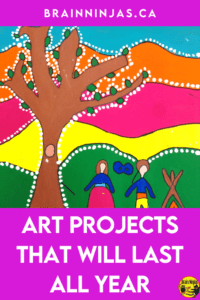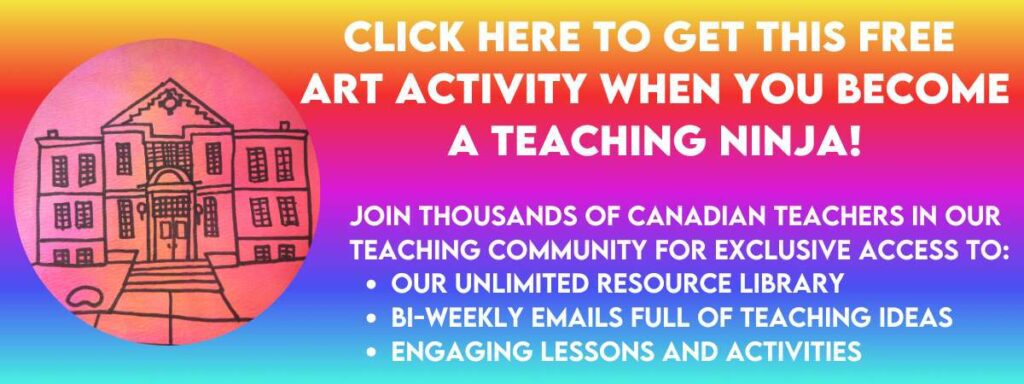
Most Canadian elementary teachers teach their own art lessons and most do not have any formal training outside of what they learned while earning their Bachelor of Education. That training can vary from a semester of learning to techniques to an afternoon painting one watercolour painting. Don’t worry, ninjas, we got a collection of art projects that will last all year. No planning needed!
Our List of Art Materials We Keep in our Classroom All Year
In a big school, there are pros and cons. One of the pros is that the school probably owns a lot of art supplies, but one of the cons is that sometimes it can be hard to track down those materials or some items are in hot demand.
Paintbrushes
After years of never being able to find the paintbrushes, we decided to buy our own set. It was an investment upfront, but having our own set of Tempera brushes and a set of watercolour brushes that we could use whenever we needed them, saved us a lot of time searching and the anxiety of switching lessons at the last moment. We kept these brushes hidden so that we never had to worry they would disappear.
Most of all, we taught our students how to properly clean and care for the brushes so they lasted for YEARS. Nothing was more frustrating than finding the brushes and half of them were still caked with paint or looked like they’d been used to paint gravel.

Paper
We grab a collection of paper at the beginning of the year and then store it in a dark drawer to get the most out of it. Watercolour paper is expensive so we take the time to cut it down into pieces that fit nicely in the drawer and label it so that no one uses it for another reason.
Scrap paper (usually paper with one good side) can be found almost anywhere. We take some of this paper to cut into quarters to make little notebooks. Once the paper is cut, we make little stacks and staple them twice across the top. This is a great job for a volunteer or even a student. We keep a paper tray of scrap paper available for students to use anytime (including math).
Plates, Cups or Palettes
We have a set of old ice cream bucket lids that we reuse year after year for paint palettes. Some of the lids are fifteen years old, but we still use them regularly. While the kids clean them on a regular basis, once a term we bring them home and throw them in the dishwasher for a good clean.
One of the best tips we found, was to cover the lids in plastic wrap or wax paper. During clean-up time, the plastic or paper gets thrown away. This is the way to go when you don’t have access to a sink right away. For more tips about cleaning up art class read: Are You Avoiding Teaching Art?
Years ago we found a set of low and wide cups that are perfect to use for water cups because they don’t spill easily. Easter egg dipping cups are great, too. Avoid using little plastic cups because they are often very tippy once there’s water in them. Train your students to fill their cups only halfway.

Glue
We’ve probably lost about eight glue guns over the years, but we always keep a few in our classroom along with a supply of hot glue. We use white glue most often for projects so that students can do their own gluing, but it takes much longer to dry. Students have glue sticks in their personal materials, but it isn’t great for every project.
We recommend investing in a few cheap hot glue guns. The investment is worth the time and you can control who uses them.
Tablecloths and Paint Shirts
Over the years we’ve collected plastic-covered tablecloths because they are perfect for painting or other messes. Train your students to wash up and fold them for storage.
Ask your families for some old large shirts that can be worn by students to protect their clothing during art. Not all our students wear them all the time, but they come in handy if someone is wearing something special during art.
Clean-Up Tools
We have a set of little brooms and dustpans so students can clean up the floor after art. They take care of it and the brooms are perfect when one of those little handheld sharpeners drops.
Our class has a set of washcloths so students don’t have to use up tons of paper towels to wipe up spills. We keep paper towels in the room, too, but we try to use them mostly for drying hands since it is school-grade paper and doesn’t really soak up water.
List of Art Materials We Use That the School Owns

Paint
It’s not possible to keep all the paint in your classroom. It takes up too much room, so we tend to collect the paint we need before each project. The watercolour palettes in our school are booked by teachers, so we try to plan out when we’ll use them. If you have the space and money, we recommend getting your own set of watercolour paints because you can control how they are cleaned (or how dirty they get in the first place).
Clay/Kiln
We don’t do a lot of clay projects because our kiln is incredibly expensive to run. Our school doesn’t keep air dry clay in stock and teachers order it in advance of projects. To help make this efficient, we’ll plan out a whole unit to work with the clay.
Clay tools for making special details, cutting, scoring or rolling are too expensive to buy our own sets, so we use the set from the school. They are in pretty rough shape and many people don’t clean them properly, but they aren’t used as often, so the time is worth not spending money.
Brayers, Rollers and Printmaking Materials
The special paint and tools required for detailed printing are too expensive and not used frequently enough to own our own. They take up a lot of room and they are only used a few times a year.
List of Materials We Collect to Use Throughout the Year
Miscellaneous Crafting Supplies
Items like googly eyes, beads, felt and fabric scraps are pretty easy to store so we recommend keeping a little container of them in your classroom. Our students are allowed to use these items during makerspace work or art (when the project allows) and we don’t have to search out little pieces.
Students often contribute to this mismatched collection. At the beginning of the year, we let families know that we take crafting donations from leftover projects. Every year we collect more than we need. It’s easy to let students use the supplies liberally because there’s not a big cost to us.
Cardboard
We ask families to send in clean, flat and dry cereal boxes. The cardboard can be used for so many different projects. When we have a specific project in mind, we’ll ask for cardboard boxes that have more stiff cardboard.
Recyclable Materials
Some of our projects use recycled materials like plastic food containers, jars, lids or straws. Use single-use items to keep them out of the recycling bin or landfills. These materials are usually collected with specific projects in mind.
What projects do we do?
Over the years we’ve collected different projects. Sometimes projects are pulled together in a unit or common theme. Sometimes, we just do the ones we love. We wrote lessons out in detailed steps so you can recreate them with your students. Now we have a whole year’s worth.
Grab these lesson sets!
Artists of Canada Art Projects These focus on styles and works from different Canadian artists. Find it in our TpT Store ($USD) or our BN Shop ($CAN).
Indigenous Artists in Canada Art Projects These focus on styles and works from different Canadian artists who identify as First Nations, Métis or Inuit. Find it in our TpT Store ($USD) or our BN Shop ($CAN). You can try a lesson from this set in this post.
Landscape and Geography Art Projects These look at how landscapes and geographical features can be turned into art. Find it in our BN Shop ($CAN).
Science Related Lessons
Light and Shadow Projects These use elements of light to shadow to create art. It works great to combine this unit with your science lessons. Find it in our TpT Store ($USD) or our BN Shop ($CAN).
Plants Art Projects These use elements of plants and flowers to create art. They work great combined with your science lessons. Find it in our TpT Store ($USD) or our BN Shop ($CAN). Try this free poppy lesson from our TpT Store or BN Shop.
Recycled Materials Art Projects These use up materials so they don’t get thrown away. Find it in our TpT Store ($USD) or our BN Shop ($CAN). Try this lesson for free when you sign up for our email list or find a copy in our Resource Library. We use these lessons as part of our Waste in Our World Science Unit.
Holiday or Seasonal Related Lessons
Christmas Art Projects These lessons include lessons that are inspired by the Christmas season. Find it in our TpT Store ($USD) or our BN Shop ($CAN).
Winter Art Projects Since winter in Canada lasts months, you can do these any time of the school year. 😉 Find it in our TpT Store ($USD) or our BN Shop ($CAN).
Halloween Art Projects Even though this set is titled Halloween, all of the projects can be adjusted to use monsters or aliens at any time of year. Find it in our TpT Store ($USD) or our BN Shop ($CAN).
Save your time and money and get all of our art projects in one big bundle. Find it in our TpT Store ($USD) or our BN Shop ($CAN).
Looking for more art projects?
We have lots of different projects on our site.
Back to School Art Projects – This post includes five free projects.
Heart Art Projects You’ll Love – This post includes ideas for art projects using a simple heart shape.
Turkey Painting – This project can be found in our Resource Library, or we can send it to you when you sign up for our email list.
Christmas Themed Art Projects and Crafts
Fingerprint Art
Recycled Wreaths
Recycled Pringle Can Characters
Wooden Ornaments
Paper Ornaments
Handmade Christmas Cards
Recycled Cork Ornaments
Christmas Stocking Creatures
Simple Christmas Tree Projects We Love
Holi Art Projects are included in our post about Holi the Hindu Festival of Colours.
Simple and Stunning Remembrance Day Art Projects (most are poppy projects) and Create Memorable Remembrance Day Art Projects (most are not poppy projects)
What is your favourite art project? Tell us about it in the comments below.









